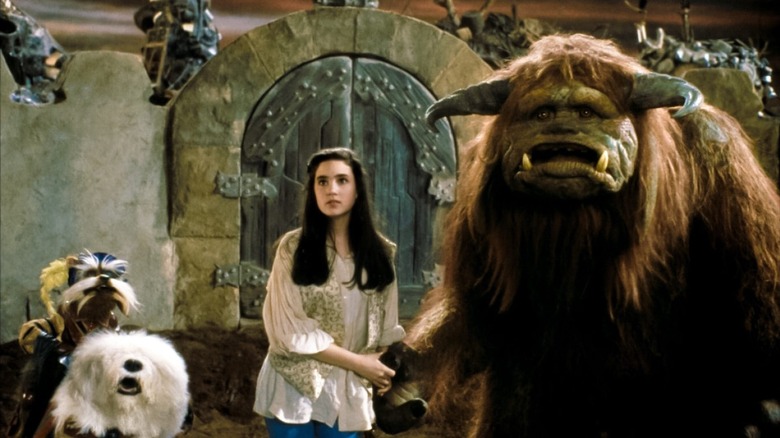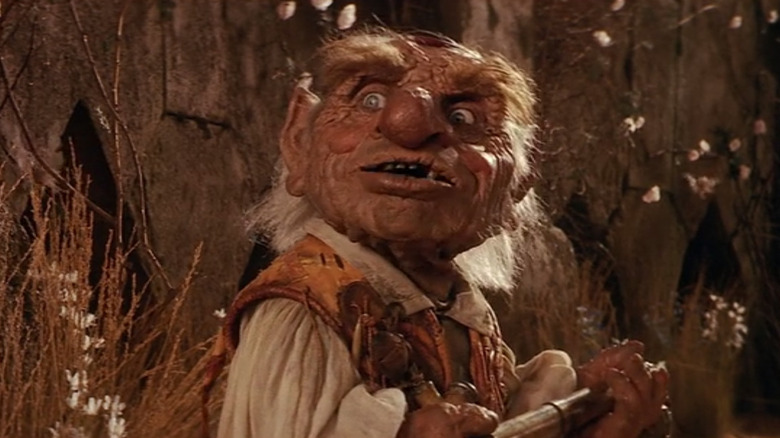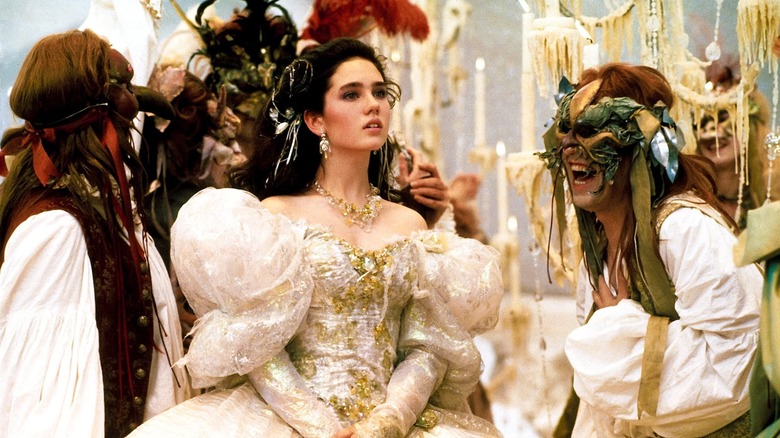Labyrinth Wasn't Quite The Story Terry Jones Was Trying To Tell
Jim Henson's 1986 fantasy film "Labyrinth" is an odd duck, and not because of its copious amount of fantasy creatures. While the film's many passionate fans are generally drawn to David Bowie as Jareth the Goblin King, the glam rocker's presence seemed antithetical to Henson's own musical sensibilities, which tended toward gentle folk rock and John Denver. In casting Bowie as a villain, was Henson commenting subtly on his music? "Labyrinth" was met with only warm reviews on its release, with some critics praising its craftsmanship, but lambasting its scattered and unfocused story. Roger Ebert, perhaps infamously, gave the film only two stars, feeling it insubstantial. No doubt its legion of enthusiasts, who gather for annual fancy-dress balls, have more glowing, sophisticated things to say than the critics.
The critical observation about the film's lack of focus may stem from the fact, however, that screenwriter Terry Jones never felt he was able to present a coherent vision of what he wanted. In a 2016 oral history with Empire Magazine, Jones and several others reflected on production, and how slapped-together the picture felt at times.
Hoggle spraying fairies
"Labyrinth," for those unfamiliar, tells the story of a bratty 16-year-old named Sarah (Jennifer Connelly) who resents having to babysit her baby brother when she would rather be re-enacting scenes from her favorite fantasy stories out in the woods. When she spitefully calls out to imaginary goblins to take her brother away, she accidentally summons the very real Goblin King, who hides her brother in the middle of a vast, magical labyrinth just appeared outside her door. Regretful, Sarah treks into the maze, encountering the many fantastical creatures that live therein. Like in "The Wizard of Oz," she accumulates a team of charismatic companions: The gnome Hoggle (Brian Henson and Shari Weiser), the snippy human fox Sir Didymus (Dave Goelz), the gentle genoskwa Ludo (Ron Mueck), as well as a Toto of her own. With them, she traverses the labyrinth's many twists and turns, solves riddles, and endures the advances of David Bowie.
Those twists and turns were compiled from several of Jones' drafts, leading to a rickety structure and bits and pieces stuck together with gum and tape. Says Jones:
"It sort of fell between two stools. It didn't really end up as the story I wanted to tell, but I don't know if it was quite the story Jim imagined either. I think I was a bit nervous about how much of what I wrote would end up in the film, but it does mostly resemble my second draft. The hands that help Sarah down the shaft are mine, and the hat that talks back to the old man. The Bog Of Eternal Stench? Yes, that sounds like me!"
So who wrote the rest? Jones doesn't seem to rightly recall.
The girl was not sympathetic
Dave Goelz, a longtime Muppet performer (perhaps best known for playing The Great Gonzo), admitted that he was put off by the depiction of Sarah, feeling she was perhaps too unrealistic. It look him several viewings and many years to understand what was going on — Sarah was a typical teen. He admits to loving the film now:
"At first I felt the girl was not sympathetic, but I'd never had a teenage daughter at that time. I didn't realize that this is a normal thing! Once the film came out, I watched it a few times and I started to really feel what it was about, and now I love 'Labyrinth.' It's all over the place but it's so good in its own way."
"Labyrinth" was based on the art of Brian Froud, with many of the film's episodes and scenarios taken directly from his sketchbooks. Froud was also the primary designer on Henson's fantasy film "The Dark Crystal" in 1982. Jones, evidently, would thumb through Froud's pictures and jot out scenes on the fly, often late into production. A story wasn't necessarily cohering. Perhaps Jones was attempting something a little more open-ended, like back in his Monty Python days. Says Froud:
"It wasn't 'cobbled together' exactly, but Terry was writing new scenes very late into production. He kept flicking through my sketchbook and going, 'Ooh! I like that!' The door-knockers and the hat were classic examples. Terry just ran with that stuff. It didn't end up as his whole vision, but it wouldn't have been the same without him."
As for the story Jones intended, we can only speculate. But the years have been kind to "Labyrinth" in the public consciousness, and the film has become a slumber party standard. It doesn't belong to the creators anymore — it belongs to those who love it.


